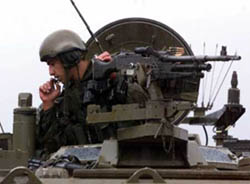 |
| Vol. 2 No. 1 | January 2000 |
As IDF forces in south Lebanon prepare for a possible withdrawal over the next several months, Israeli military analysts say that they have finally overcome many of the difficulties which led to a rise in IDF casualties in recent years. IDF casualties have now sunk to a new low--since August 17 of last year, no Israeli soldiers have been killed and only a few have been seriously injured.
 |
| No IDF soldiers have been killed in action since August 17 |
Moreover, Israeli security sources recently disclosed that IDF intelligence has infiltrated Hezbollah's network of collaborators in south Lebanon, considerably impairing the group's ability to track the movement of Israeli forces and remotely detonate roadside bombs.1 As a result, Hezbollah has been forced to rely primarily on long-range mortar attacks, the effectiveness of which has been reduced by a large-scale construction program last year to improve the fortifications of IDF and SLA outposts.
Due in part to the ineffectiveness of its conventional military operations, Hezbollah launched its first suicide bombing in several years on December 30. The bomber, driving a blue van containing a massive explosive charge, detonated the device in close proximity to a passing IDF convoy in the residential quarter of Klea, a small village less than two kilometers from Metulla in the security zone. Here again, however, new measures instituted by the IDF minimized the damage to Israeli military personnel. In accordance with recently enacted military regulations, the vehicles in the convoy maintained a significant distance from each other and all of them had reinforced armor plating. As a result, only two IDF vehicles were hit and no one inside them was injured. Lebanese civilians traveling in other cars along the same road were not so lucky. Twelve of them, including seven children, were wounded in the attack.
Perhaps the best indication of the desperation prevailing within Hezbollah is its recent tendency to issue erroneous proclamations of successful attacks. Hezbollah spokesmen claimed that many IDF soldiers were killed in the December 30 blast and repeatedly praised the "victory."
Hezbollah officials have long refused to guarantee an end to armed attacks against Israel after the withdrawal of IDF forces this year. However, in an apparent acknowledgement that its military card is slipping away, Hezbollah Secretary-General Hassan Nasrallah said this month in a televised interview that the future focus will be on fighting "normalization" with Israel rather than armed struggle. "The fight against normalization is as important as the armed struggle, because it can limit damage and block the Zionist plan," said Nasrallah. He emphatically denied that the absence of armed struggle will eliminate his group's raison d'etre. "We are a Lebanese Islamic movement which has a political presence, cultural, educational and social activities and institutions . . . all this will continue normally."2
1 Voice of Israel Radio, 9 January 2000.
2 Al-Jazira Satellite Television, 13 January 2000.